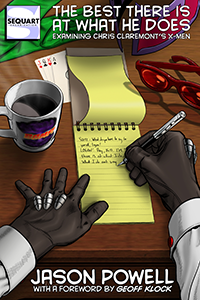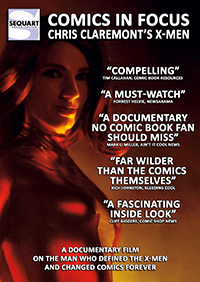 What if Marvelman woke up in the real world? That was the simple and enticing high-concept that Alan Moore wished to explore when he began to write his graphic novel Marvelman. In the hands of a great writer something as simple as “Superman landing in the Soviet Union” can be developed into something profound and thought-provoking. On the surface, Moore’s premise can sound simple and a desire to bring more realism into the superhero genre.
What if Marvelman woke up in the real world? That was the simple and enticing high-concept that Alan Moore wished to explore when he began to write his graphic novel Marvelman. In the hands of a great writer something as simple as “Superman landing in the Soviet Union” can be developed into something profound and thought-provoking. On the surface, Moore’s premise can sound simple and a desire to bring more realism into the superhero genre.
Realism has always been an aspect of superheroes since the late 1950s. As the Golden Age of comics made way for the Silver Age of comics the superhero genre shifted from fantasy-related origins to science fiction-based superpowers and origins. The science-fiction and fantasy genre are so intertwined that Bill Willingham had them personified as twin siblings in Fables (with an annoying unseen younger sibling known as “Superhero”). At their core both fantasy and science fiction include an aspect in their stories that is beyond the natural. The fantasy genre is not often moored to reality and explains the supernatural as magic. In contrast, science fiction (sometimes to a story’s detriment) focuses on providing an explanation that is within conceivable scientific possibility. Science fiction is a more realistic genre as it often hinges on a slim but genuine possibility that what is depicted can actually come to pass.
Julius Schwartz, a long-time science fiction editor came to DC Comics and brought a degree of realism to superheroes as he revamped DC’s characters. The Flash’s powers now originated from a mixture of lightning and chemicals. The Green Lantern’s magical ring was re-imagined as an alien technology. Rival publisher Marvel Comics under Stan Lee’s editorship would introduce superheroes who came from atomic accidents. Lee’s writing was additionally praised for bringing in a more “realistic” portrayal of the heroes. Spider-Man constantly struggled with guilt and a bad public perception, the Fantastic Four would constantly bicker, and the Hulk was hated and misunderstood by the Army. Realism would continue for superheroes into the 1970s with issues of bigotry being dramatized in Marvel’s X-Men. Denny O’Neil and Neal Adams had a lauded run on Green Arrow/Green Lantern in which the heroes encountered current event issues. Moore’s approach to realism was significantly different because the superhero was introduced to a world without superheroes.
It seems simple, and yet it quickly becomes profound that a character with genuine superpowers is introduced into a world with no similar people. The existence of a super-being in the real world is jarring. In the beginning of Book I: A Dream of Flying, Moore begins his intentional positioning of Marvelman not as a superhero but as a god. What helps accentuate this difference is the realistic artwork of Garry Leach. Leach’s meticulous linework conveys that the events depicted are firmly rooted in a real-world, with dirt and grime and fragile but honest human beings. Which is lightly contrasted by the introduction of Marvelman into the world. It was Leach who proposed that Marvelman have an aura that surrounded him, thus giving Marvelman and his family the “Tinkerbell” effect that defined the modern interpretation of the characters. Even as Lloyd left early in the series, the artists would continue to present the story in a realistic manner at points. From the Rick Veitch’s unflinching depiction of childbirth to the horrifically graphic depiction of violence by John Totleben, no artist on Marvelman refrained from anchoring a story of superheroes with realism.
As the world is drawn and written to be grounded in the real world. With this commitment to realism Moore introduces the deconstruction of the superhero genre that would become popularized from the 1980s onwards. In the second chapter in Book I: A Dream of Flying, Liz Moran cannot help but laugh at the absurdity of key elements to Mike Moran’s supposed history. The magical origins of Marvelman’s superpowers, having a superhero whose real name was Dicky Dauntless, a superpowered dog and villains like Young Nastyman are met with laughs. Although Liz wants to be supportive and understanding towards her husband the superhero genre does not stand the test of reality. Eventually Moore offers an origin for Marvelman that is more acceptable for high science-fiction. Utilizing alien technology is ultimately presented as more plausible to the 1950s magical technology. Why Moore succeeds in making aliens more plausible than magic because the aliens are presented with similar human issues. Though the alien species the Qys and Warpsmith’s are far more advanced technologically, the two are embroiled in a bitter cold war that Marvelwoman helps to ease tensions with by offering to make Earth a melding of the cultures of the two species. A politically realistic depiction of alien species helps to make their advanced technology seem more plausible.
As Moore has Marvelman transcend the superhero genre into high science-fiction he anchors the story with a palpable emotional realism. In most superhero stories there is the love-triangle between a love interest, the superhero and his alter ego. Typically, we have Lois Lane in love with Superman and bored by mild-mannered Clark Kent. Yet, in Marvelman, Liz Moran’s response to her husband’s superhero identity is much more complicated. Liz Moran serves as the human and moral center throughout Moore’s Mavelman. Marvelman’s journey throughout the graphic novel is a natural progression from pitiful news journalist to the divine ruler of Earth. All throughout this journey is Mike Moran’s wife Liz who slowly grows exhausted by the world of the superheroes.
An underlining theme in the traditional superhero genre is the notion that women prefer the strong and confident persona’s presented by the superhero. The insecure and human Peter Parker persona is not originally met with numerous love interests. It is only when the superhero persona begins to inform the human identity that women are attracted to the human. Marvelman inverts the trend and presents a more realistic response of discomfort and eventual rejection when the superhero becomes the dominant personality. When Liz Moran first see’s her husband as Marvelman she is terrified rather than attracted. She jokingly remarks that she prefers ugly men at one point in the graphic novel. She trembles slightly as she sees Marvelman turn back to Mike Moran. Liz Moran is not at all comfortable with her husband having godlike powers. Even in moments of passion Liz Moran narrates, “There is nothing to be afraid of.” But she privately confesses, “So why does she feel so vulnerable. And afraid.” Even though Marvelman remains passionately in love with Liz, he ultimately cannot comfort Liz. While Marvelman becomes transfixed and mesmerized by the expanding world of superheroes and aliens Liz recoils in terror. Liz tearfully remarks that, “I’m only human Mike. And you’re not.” The world of the superheroes is too strange for any ordinary person to handle.
Marvelman soon becomes the dominant personality for Mike Moran, and he struggles to empathize with Liz. Marvelman lovingly and longingly describes Liz as gentle with her love for him being animal and clean. Marvelman’s words are more detached. In the final chapter of Book III: Olympus Marvelman offers the solution of making Liz a super-being too. Liz, however, is disgusted that Marvelman cannot understand Liz being jealous of her husband’s sexual relationship with Marvelwoman. Liz proudly takes root on her humanity and confounds Marvelman by declaring, “you’ve forgotten what your asking me to give up.” As Marvelman has now truly become a god he cannot understand the insecurities and emotions of humanity. There is a true emotional realism that Marvelman’s power inevitably causes him to become distant from humanity. Moore & Totleben visualize this distance with the god Marvelman standing on the balcony of his four-mile high pyramid contemplating his wife’s refusal. By the end of Moore’s Marvelman gods walk amongst men, the dead live, crime is gone as is war and poverty, nuclear weapons are removed. Marvelman and his pantheon of gods have created a Utopia on Earth. The superhero’s destiny is to make the real world into the world of mythology. Yet Moore’s never escapes his original realism as there is an emotional realism amongst all-powerful beings. Moore’s realism amid mythology is having a god have a worm of doubt about his paradise.




























































